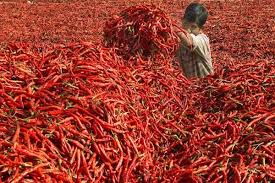
The red chilli market is currently experiencing a significant downturn, primarily driven by an oversupply and weak demand both domestically and internationally. Several factors are contributing to this decline, affecting market dynamics and pricing.
One major factor influencing the Indian red chilli market is the low export demand from neighboring countries such as Sri Lanka, Bangladesh, and Pakistan. These countries have been selling red chillies at reduced prices due to the devaluation of their currencies, making it challenging for Indian exporters to compete. Consequently, this has led to an oversupply in the domestic market, exerting further downward pressure on prices.
The high prices of the previous season prompted farmers in regions like Guntur, Madhya Pradesh, Bihar, Bengal, and Uttar Pradesh to significantly increase chilli cultivation. Additionally, traders stocked up on chillies at high prices at the beginning of the season. However, the expected demand failed to materialize, resulting in a market glut. This oversupply is now being sold off at reduced prices, compounded by the added costs of interest and freight.
Another contributing factor to the market decline is the reduced consumption of red chillies. The absence of weddings and large gatherings in May and June, typically peak seasons for chilli consumption, has significantly impacted demand. Consequently, the market has been unable to absorb the excess supply, leading to further price reductions.
Old stocks of red chillies remain plentiful, particularly in the Bareilly and Indore markets, where they are being sold at lower prices. This abundance is adding additional downward pressure on the market. Similar situations are observed across various regions, with large farmers who had held onto their stocks now releasing them into the market.
Given the current conditions, it is advisable for market participants to avoid long-term bullish positions until the new crop arrives. The combination of high stock levels, weak export demand, and low domestic consumption suggests that prices will remain subdued in the near term. Traders and farmers should closely monitor market developments and adjust their strategies accordingly to navigate this challenging period.
The red chilli market is facing a challenging period due to an oversupply and weak demand both domestically and internationally. The current market dynamics underscore the importance of cautious trading and strategic planning. By mitigating losses and preparing for better opportunities when the new crop arrives, market participants can better manage the present downturn and position themselves for future growth.
Source: Commodity Board